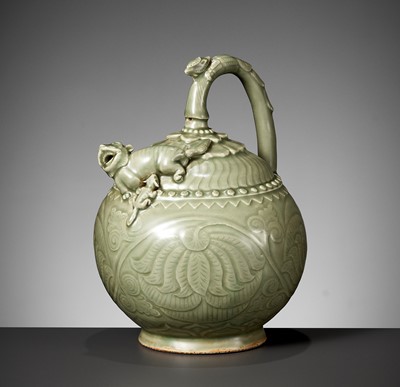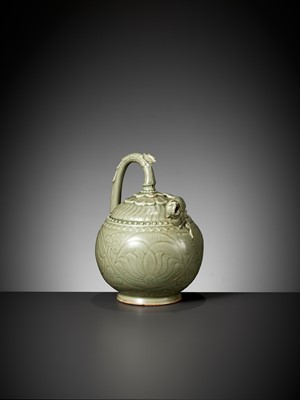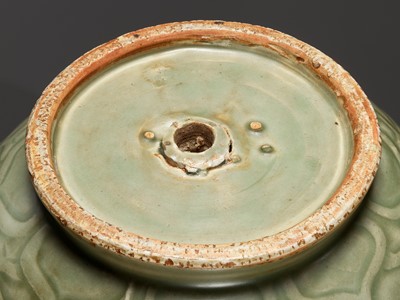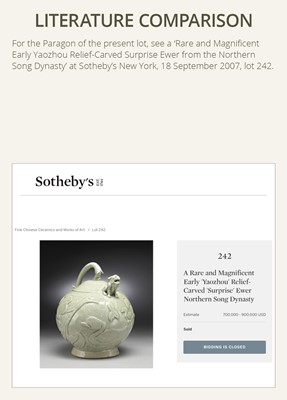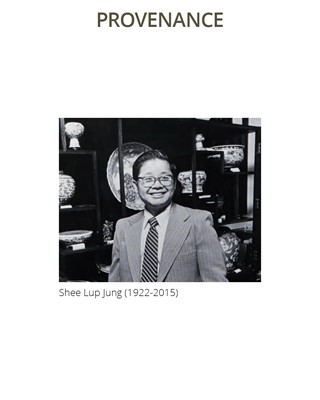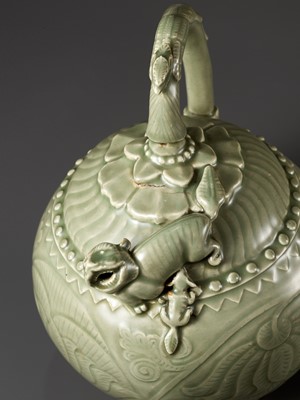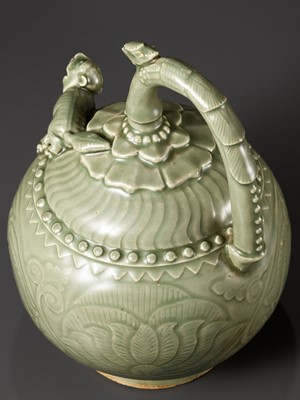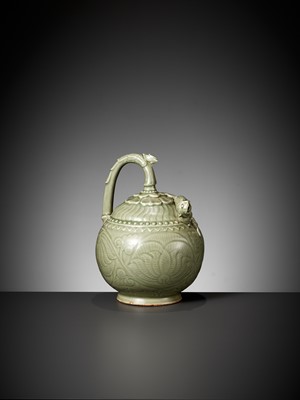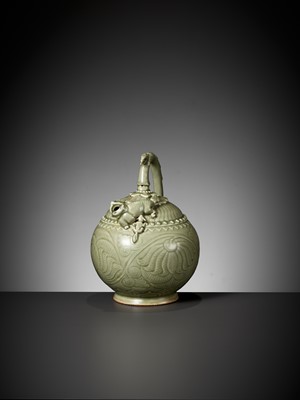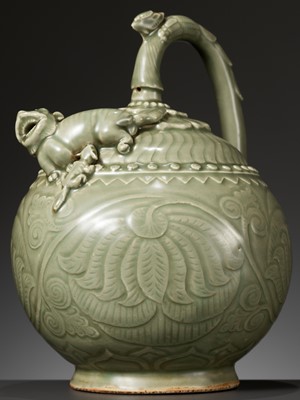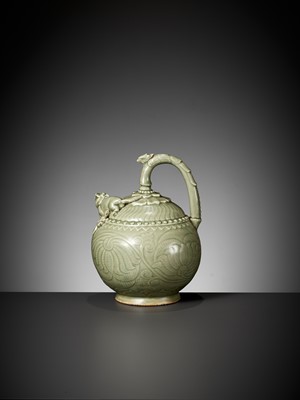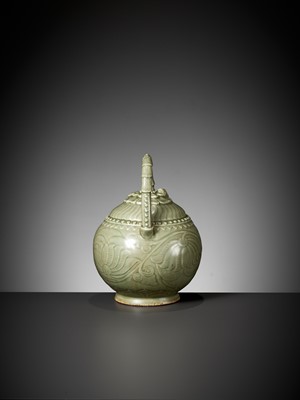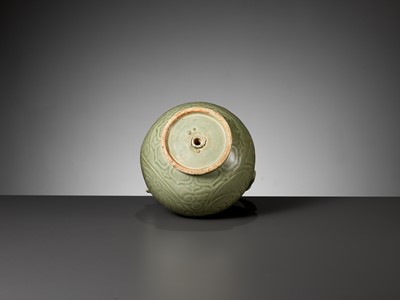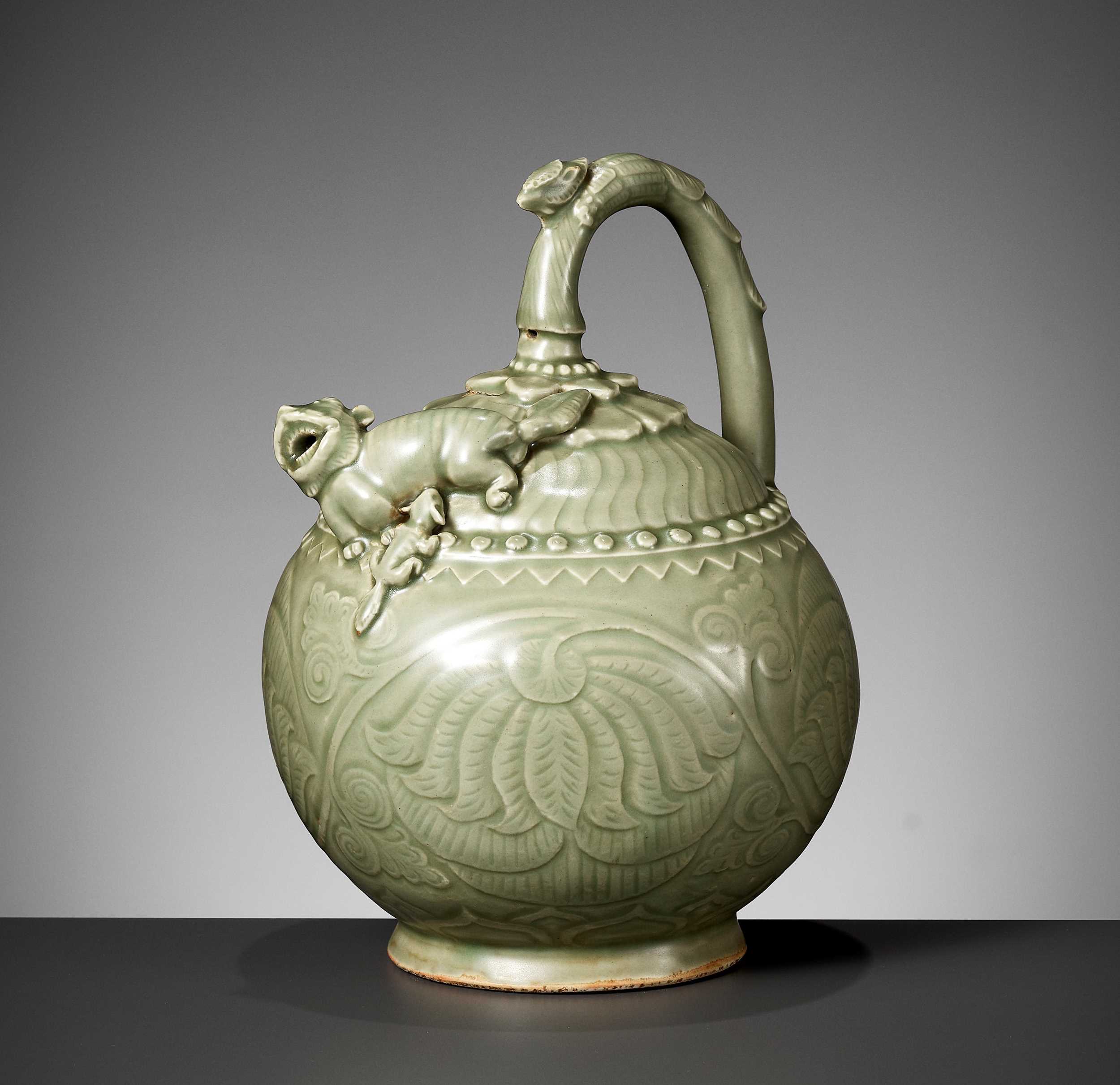19th Jan, 2023 11:00
Asian Art Discoveries
576
A CELADON GLAZED ‘SURPRISE’ EWER WITH A ‘LION’ SPOUT, QING DYNASTY
清代青釉提梁倒灌壺
Sold for €3,120
including Buyer's Premium
China, 1644-1912 or earlier. The globular body supported on a short spreading foot, decorated with neatly incised lotus flowers borne on scrolling vines, the shoulder carved with diapered borders to delineate the simulated cover in the form of a stylized lotus flower. The top and shoulder set with a long curved handle with a phoenix head and wings, the shoulder with a Buddhist lion forming the spout of the ewer, a small cub nestling to its side.
Provenance: Jung’s, Inc., Wilmington, Delaware, USA, 1990s. Lawrence H. Dunbar, Jr. (d. 2008), Chadds Ford, Pennsylvania, USA, acquired from the above and thence by descent within the family. Jung’s, Inc. was an art and antiques dealership founded by Shee Lup Jung (1922-2015). Mr. Jung received his PhD in Chemistry from the University of Pennsylvania in 1951, when he was employed as a research chemist for DuPont. Inspired by his wife Mary’s passion for the arts, Mr. Jung slowly and methodically studied ancient glazes and ceramics, including their chemical and mineral aspects, acquiring a multitude of study pieces for the family’s collection. In 1975, he started Jung’s, Inc. in a historic location in central Wilmington, Delaware, as a museum-like gallery with an impressive selection of ceramics, open by appointment only and selling mostly to knowledgeable and scholarly collectors much like Jung himself.
Condition: Very good condition commensurate with age. Some old wear, traces of use, and shallow surface scratches. Manufacturing flaws such as firing cracks and brown spots, four distinct spur marks to base, kiln grit, some firing splits associated with the insertion of the filling tube, the foot rim with some chips most of which have been worn down over time, the unglazed areas of the ware partially burnt to orange in the firing. Few minuscule nicks here and there, minor glaze losses. The ewer may be filled through the tube, but the spout is clogged.
Weight: 1,589 g
Dimensions: Height 24.3 cm
Covered overall in a pale olive glaze thinning at the edges and darkening in the recesses, now worn down a remarkably unctuous feeling overall. The base with a circular aperture, leading into a sturdy, raised tube located inside the ewer, thus enabling to fill the vessel from the bottom.
The ‘surprise’ consists in the fact that at first sight the vessel looks like a regular teapot with a cover, but after trying to fill the vessel the normal way, it quickly turns out that the ‘mock’ lid cannot be removed. Only after turning the pot upside down, an aperture is revealed. This leads to an elongated tube hidden inside the vessel, which prevents the water from flowing out through the aperture once the pot has been filled.
Expert’s note: ‘Surprise’ ewers of this type, which are filled from the base through a tube located inside the vessel, are an ingenious and clever invention that dates back to the Northern Song dynasty. See literature comparison below for an example that sold for $668,000 in September 2007. During the later Ming era and through most of the Qing dynasty, a number of reproductions of these famed ewers were made both at the Longquan kilns and in Jingdezhen. The present lot clearly belongs to this group of earlier revival pieces, as the 20th-century copies always lack the interior tube, because its insertion into the pot after the initial firing procedure creates a complexity that modern potters simply don’t know how to handle. The elegant Longquan glaze, the distinct spur marks, the broad foot with its worn-down chipping, the unctuous feel of the glaze and the orange-burnt ware all suggest a date range of 1500-1600 for the present lot. But given the lack of any meaningful documentation, a rather cautious dating to the Qing dynasty seems more reasonable.
Literature comparison:
For the Paragon of the present lot, see a ‘Rare and Magnificent Early Yaozhou Relief-Carved Surprise Ewer from the Northern Song Dynasty’ at Sotheby’s New York, 18 September 2007, lot 242.
清代青釉提梁倒灌壺
中國,1644-1912年或更早。伏鳳式提梁,以花蒂象徵壺蓋。蓋、壺銜接處堆塑哺乳母子獅,母獅張口為流。球形壺腹部滿刻華麗的纏枝牡丹花,下飾一周蓮瓣紋。底部中心有梅花形注水孔,造型奇巧。圈足。
來源:美國特拉華州威爾明頓Jung藝廊,上世紀九十年代;美國賓夕法尼亞查兹福特Lawrence H. Dunbar (逝世於 2008年),購於上述藝廊,在同一家族保存至今。隨附一份1995年5月6日出具的藝廊發票複印件。Jung藝廊是由Shee Lup Jung(1922-2015)成立的藝術古董店。 Jung先生於 1951 年獲得賓夕法尼亞大學化學博士學位,當時他受聘為杜邦公司化學研究員。受妻子 Mary 對藝術的熱情啟發,Jung 先生開始緩慢但系統地研究古代釉料和陶瓷,包括它們的化學和礦物結構,為家族收藏提供大量的研究藏品。1975 年,他在特拉華州威爾明頓市中心的一個歷史悠久的地方成立了 Jung藝廊,這是一家博物館式的藝廊,收藏了令人印象深刻的陶瓷,只接受預約參觀,主要出售給與 Jung 本人一樣的知識淵博和學術收藏家。
品相:品相極好,與年齡相符。 一些磨損、使用痕跡和表面劃痕。製造缺陷,例如燒製裂紋和褐色斑點,底部有四個明顯的刺痕與窯砂,圈足部位有一些磕損,其中大部分區域隨著時間的推移而磨損,露胎。在燒製過程中,陶器的某些區域部分被燒成橙色。局部有微小的刻痕,輕微的釉料損失。壺可以通過管子注水,但壺口被堵塞。
重量:1,589 克
尺寸:高24.3 厘米
壺通體施青釉,略泛灰,光澤瑩潤。
在壺的底部中心有一小孔,灌水時將壺倒置,水自孔注入,當有水自壺嘴流出時即註滿,因壺內有漏柱與水相隔,壺放正時,底雖有孔而不漏,即倒灌正流。
專家注釋:此類“奇”壺可以追溯到北宋。 2007 年 9 月曾有一個以 668,000 美元成交的例子(見文獻比較)。在明清時期,龍泉窯和景德鎮都製作了許多類似的壺。本拍品顯然來自明清時期,因為二十世紀的複製品總是缺少內管,而現代陶藝家根本不知道如何製作。優雅的青釉,鮮明的刺痕以及磨損程度,青釉瑩潤和橙色露胎處都表明,此拍品的生產日期範圍為1500-1600年。但鑑於缺乏任何有意義的文獻資料,生產於清朝似乎更合理。
文獻比較:
本拍品的典範之作,是一件罕見而華麗北宋早期耀州浮雕提梁倒灌壺,紐約蘇富比,2007年9月18, lot 242。
China, 1644-1912 or earlier. The globular body supported on a short spreading foot, decorated with neatly incised lotus flowers borne on scrolling vines, the shoulder carved with diapered borders to delineate the simulated cover in the form of a stylized lotus flower. The top and shoulder set with a long curved handle with a phoenix head and wings, the shoulder with a Buddhist lion forming the spout of the ewer, a small cub nestling to its side.
Provenance: Jung’s, Inc., Wilmington, Delaware, USA, 1990s. Lawrence H. Dunbar, Jr. (d. 2008), Chadds Ford, Pennsylvania, USA, acquired from the above and thence by descent within the family. Jung’s, Inc. was an art and antiques dealership founded by Shee Lup Jung (1922-2015). Mr. Jung received his PhD in Chemistry from the University of Pennsylvania in 1951, when he was employed as a research chemist for DuPont. Inspired by his wife Mary’s passion for the arts, Mr. Jung slowly and methodically studied ancient glazes and ceramics, including their chemical and mineral aspects, acquiring a multitude of study pieces for the family’s collection. In 1975, he started Jung’s, Inc. in a historic location in central Wilmington, Delaware, as a museum-like gallery with an impressive selection of ceramics, open by appointment only and selling mostly to knowledgeable and scholarly collectors much like Jung himself.
Condition: Very good condition commensurate with age. Some old wear, traces of use, and shallow surface scratches. Manufacturing flaws such as firing cracks and brown spots, four distinct spur marks to base, kiln grit, some firing splits associated with the insertion of the filling tube, the foot rim with some chips most of which have been worn down over time, the unglazed areas of the ware partially burnt to orange in the firing. Few minuscule nicks here and there, minor glaze losses. The ewer may be filled through the tube, but the spout is clogged.
Weight: 1,589 g
Dimensions: Height 24.3 cm
Covered overall in a pale olive glaze thinning at the edges and darkening in the recesses, now worn down a remarkably unctuous feeling overall. The base with a circular aperture, leading into a sturdy, raised tube located inside the ewer, thus enabling to fill the vessel from the bottom.
The ‘surprise’ consists in the fact that at first sight the vessel looks like a regular teapot with a cover, but after trying to fill the vessel the normal way, it quickly turns out that the ‘mock’ lid cannot be removed. Only after turning the pot upside down, an aperture is revealed. This leads to an elongated tube hidden inside the vessel, which prevents the water from flowing out through the aperture once the pot has been filled.
Expert’s note: ‘Surprise’ ewers of this type, which are filled from the base through a tube located inside the vessel, are an ingenious and clever invention that dates back to the Northern Song dynasty. See literature comparison below for an example that sold for $668,000 in September 2007. During the later Ming era and through most of the Qing dynasty, a number of reproductions of these famed ewers were made both at the Longquan kilns and in Jingdezhen. The present lot clearly belongs to this group of earlier revival pieces, as the 20th-century copies always lack the interior tube, because its insertion into the pot after the initial firing procedure creates a complexity that modern potters simply don’t know how to handle. The elegant Longquan glaze, the distinct spur marks, the broad foot with its worn-down chipping, the unctuous feel of the glaze and the orange-burnt ware all suggest a date range of 1500-1600 for the present lot. But given the lack of any meaningful documentation, a rather cautious dating to the Qing dynasty seems more reasonable.
Literature comparison:
For the Paragon of the present lot, see a ‘Rare and Magnificent Early Yaozhou Relief-Carved Surprise Ewer from the Northern Song Dynasty’ at Sotheby’s New York, 18 September 2007, lot 242.
清代青釉提梁倒灌壺
中國,1644-1912年或更早。伏鳳式提梁,以花蒂象徵壺蓋。蓋、壺銜接處堆塑哺乳母子獅,母獅張口為流。球形壺腹部滿刻華麗的纏枝牡丹花,下飾一周蓮瓣紋。底部中心有梅花形注水孔,造型奇巧。圈足。
來源:美國特拉華州威爾明頓Jung藝廊,上世紀九十年代;美國賓夕法尼亞查兹福特Lawrence H. Dunbar (逝世於 2008年),購於上述藝廊,在同一家族保存至今。隨附一份1995年5月6日出具的藝廊發票複印件。Jung藝廊是由Shee Lup Jung(1922-2015)成立的藝術古董店。 Jung先生於 1951 年獲得賓夕法尼亞大學化學博士學位,當時他受聘為杜邦公司化學研究員。受妻子 Mary 對藝術的熱情啟發,Jung 先生開始緩慢但系統地研究古代釉料和陶瓷,包括它們的化學和礦物結構,為家族收藏提供大量的研究藏品。1975 年,他在特拉華州威爾明頓市中心的一個歷史悠久的地方成立了 Jung藝廊,這是一家博物館式的藝廊,收藏了令人印象深刻的陶瓷,只接受預約參觀,主要出售給與 Jung 本人一樣的知識淵博和學術收藏家。
品相:品相極好,與年齡相符。 一些磨損、使用痕跡和表面劃痕。製造缺陷,例如燒製裂紋和褐色斑點,底部有四個明顯的刺痕與窯砂,圈足部位有一些磕損,其中大部分區域隨著時間的推移而磨損,露胎。在燒製過程中,陶器的某些區域部分被燒成橙色。局部有微小的刻痕,輕微的釉料損失。壺可以通過管子注水,但壺口被堵塞。
重量:1,589 克
尺寸:高24.3 厘米
壺通體施青釉,略泛灰,光澤瑩潤。
在壺的底部中心有一小孔,灌水時將壺倒置,水自孔注入,當有水自壺嘴流出時即註滿,因壺內有漏柱與水相隔,壺放正時,底雖有孔而不漏,即倒灌正流。
專家注釋:此類“奇”壺可以追溯到北宋。 2007 年 9 月曾有一個以 668,000 美元成交的例子(見文獻比較)。在明清時期,龍泉窯和景德鎮都製作了許多類似的壺。本拍品顯然來自明清時期,因為二十世紀的複製品總是缺少內管,而現代陶藝家根本不知道如何製作。優雅的青釉,鮮明的刺痕以及磨損程度,青釉瑩潤和橙色露胎處都表明,此拍品的生產日期範圍為1500-1600年。但鑑於缺乏任何有意義的文獻資料,生產於清朝似乎更合理。
文獻比較:
本拍品的典範之作,是一件罕見而華麗北宋早期耀州浮雕提梁倒灌壺,紐約蘇富比,2007年9月18, lot 242。
Zacke Live Online Bidding
Our online bidding platform makes it easier than ever to bid in our auctions! When you bid through our website, you can take advantage of our premium buyer's terms without incurring any additional online bidding surcharges.
To bid live online, you'll need to create an online account. Once your account is created and your identity is verified, you can register to bid in an auction up to 12 hours before the auction begins.
Intended Spend and Bid Limits
When you register to bid in an online auction, you will need to share your intended maximum spending budget for the auction. We will then review your intended spend and set a bid limit for you. Once you have pre-registered for a live online auction, you can see your intended spend and bid limit by going to 'Account Settings' and clicking on 'Live Bidding Registrations'.
Your bid limit will be the maximum amount you can bid during the auction. Your bid limit is for the hammer price and is not affected by the buyer’s premium and VAT. For example, if you have a bid limit of €1,000 and place two winning bids for €300 and €200, then you will only be able to bid €500 for the rest of the auction. If you try to place a bid that is higher than €500, you will not be able to do so.
Online Absentee and Telephone Bids
You can now leave absentee and telephone bids on our website!
Absentee Bidding
Once you've created an account and your identity is verified, you can leave your absentee bid directly on the lot page. We will contact you when your bids have been confirmed.
Telephone Bidding
Once you've created an account and your identity is verified, you can leave telephone bids online. We will contact you when your bids have been confirmed.
Classic Absentee and Telephone Bidding Form
You can still submit absentee and telephone bids by email or fax if you prefer. Simply fill out the Absentee Bidding/Telephone bidding form and return it to us by email at office@zacke.at or by fax at +43 (1) 532 04 52 20. You can download the PDF from our Upcoming Auctions page.
How-To Guides
How to Create Your Personal Zacke Account
How to Register to Bid on Zacke Live
How to Leave Absentee Bids Online
How to Leave Telephone Bids Online
中文版本的操作指南
创建新账号
注册Zacke Live在线直播竞拍(免平台费)
缺席投标和电话投标
Third-Party Bidding
We partner with best-in-class third-party partners to make it easy for you to bid online in the channel of your choice. Please note that if you bid with one of our third-party online partners, then there will be a live bidding surcharge on top of your final purchase price. You can find all of our fees here. Here's a full list of our third-party partners:
- 51 Bid Live
- EpaiLive
- ArtFoxLive
- Invaluable
- LiveAuctioneers
- the-saleroom
- lot-tissimo
- Drouot
Please note that we place different auctions on different platforms. For example, in general, we only place Chinese art auctions on 51 Bid Live.
Bidding in Person
You must register to bid in person and will be assigned a paddle at the auction. Please contact us at office@zacke.at or +43 (1) 532 04 52 for the latest local health and safety guidelines.
